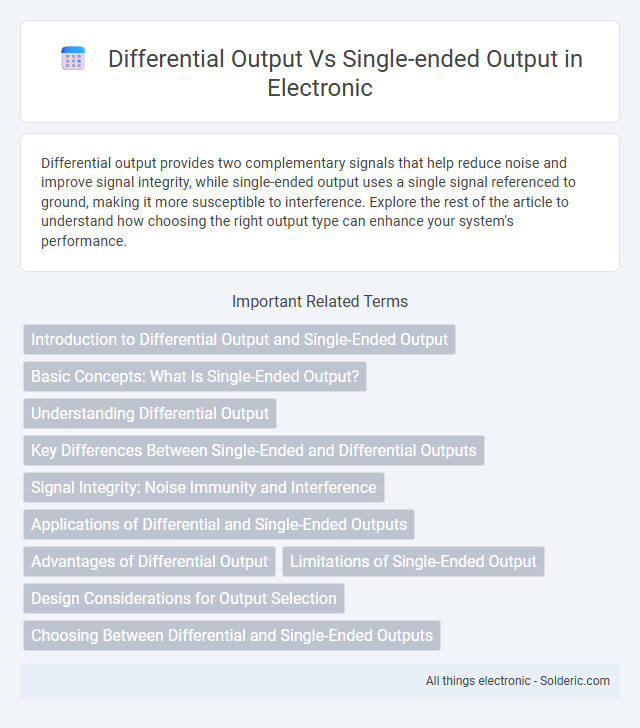Differential output provides two complementary signals that help reduce noise and improve signal integrity, while single-ended output uses a single signal referenced to ground, making it more susceptible to interference. Explore the rest of the article to understand how choosing the right output type can enhance your system's performance.
Comparison Table
| Feature | Differential Output | Single-Ended Output |
|---|---|---|
| Signal Type | Two complementary signals (positive and negative) | Single signal referenced to ground |
| Noise Immunity | High - cancels common-mode noise | Low - more susceptible to noise |
| Voltage Swing | Twice that of single-ended (due to differential pair) | Limited by supply voltage |
| Signal Integrity | Better over long distances and high frequencies | Degrades faster over distance |
| Complexity | Higher complexity; requires differential receivers | Lower complexity; basic receivers |
| Common Applications | High-speed data links, audio interfaces, instrumentation | Basic data lines, simple sensors, audio outputs |
| Power Consumption | Generally higher due to dual signals | Lower power consumption |
Introduction to Differential Output and Single-Ended Output
Differential output transmits signals using two complementary voltage lines, enhancing noise immunity and signal integrity in high-speed communication and sensitive analog applications. Single-ended output uses a single voltage line referenced to ground, making it simpler and more cost-effective but more susceptible to noise and electromagnetic interference. Differential signaling is preferred in environments requiring robust data transmission, while single-ended output suits less demanding, low-frequency circuits.
Basic Concepts: What Is Single-Ended Output?
Single-ended output refers to a signal transmission method where the output voltage is measured with respect to a common ground or reference point, using a single conductor. This type of output is simpler and more cost-effective, but it is more susceptible to noise and interference because any noise on the ground line affects the signal integrity. Single-ended outputs are commonly used in audio devices, sensors, and low-speed analog circuits where signal integrity is less critical.
Understanding Differential Output
Differential output transmits signals using two complementary voltages, enhancing noise immunity and signal integrity compared to single-ended output that uses a single voltage referenced to ground. This method reduces electromagnetic interference and crosstalk, making it ideal for high-speed data communication and audio applications. Devices like operational amplifiers, ADCs, and DACs often employ differential outputs to achieve precise and accurate signal transmission.
Key Differences Between Single-Ended and Differential Outputs
Single-ended outputs transmit a signal referenced to a common ground, making them more susceptible to noise and electromagnetic interference, especially over long distances. Differential outputs use two complementary signals, improving noise immunity by allowing the receiver to reject common-mode noise and interference. This results in enhanced signal integrity, higher data rates, and better performance in electrically noisy environments.
Signal Integrity: Noise Immunity and Interference
Differential output enhances signal integrity by transmitting two complementary signals, effectively canceling out common-mode noise and significantly improving noise immunity compared to single-ended output. Single-ended output transmits a single signal referenced to ground, making it more susceptible to electromagnetic interference (EMI) and ground noise, which degrades signal quality. By using differential output, your communication systems achieve higher resilience against interference, ensuring clearer and more reliable data transmission in electrically noisy environments.
Applications of Differential and Single-Ended Outputs
Differential outputs are widely used in high-speed communication systems, audio equipment, and sensor interfaces due to their superior noise immunity and signal integrity over long distances. Single-ended outputs are common in simpler, low-frequency applications such as basic audio devices, microcontroller signals, and consumer electronics where cost and simplicity are prioritized. Your choice between differential and single-ended outputs depends on factors like required noise rejection, signal range, and system complexity.
Advantages of Differential Output
Differential output provides superior noise immunity by transmitting signals through two complementary lines, effectively canceling out electromagnetic interference and reducing signal degradation. This method enhances signal integrity over long distances and in electrically noisy environments, making it ideal for high-speed data communication. Moreover, differential output minimizes ground loop issues and improves overall system reliability by maintaining a consistent reference voltage between devices.
Limitations of Single-Ended Output
Single-ended output signals are more susceptible to noise and interference because they reference only a single ground, leading to potential signal degradation over long distances. This type of output often suffers from lower signal integrity and reduced common-mode noise rejection compared to differential output, which transmits two complementary signals. Your designs may experience performance limitations in high-precision or high-speed applications when relying solely on single-ended output configurations.
Design Considerations for Output Selection
Design considerations for output selection involve balancing noise immunity, signal integrity, and power consumption. Differential outputs offer superior noise rejection and minimize electromagnetic interference, making them ideal for high-speed, long-distance communication. Single-ended outputs consume less power and simplify circuit design, but are more susceptible to noise and signal degradation in adverse environments.
Choosing Between Differential and Single-Ended Outputs
Differential outputs provide enhanced noise immunity and signal integrity by transmitting complementary signals over two wires, making them ideal for long cable runs or electrically noisy environments. Single-ended outputs are simpler, cost-effective, and suitable for short-distance connections with low noise challenges. Choosing between differential and single-ended outputs depends on factors like cable length, noise susceptibility, system complexity, and cost considerations.
differential output vs single-ended output Infographic

 solderic.com
solderic.com